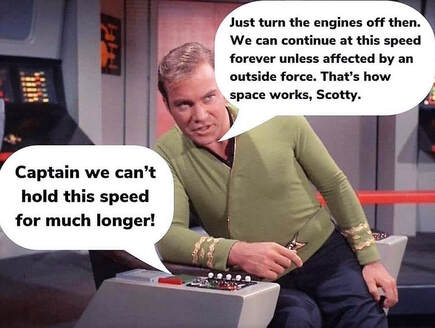Dynamics is a subset of Mechanics, which is the study of motion. Whereas kinematics analysis the motion itself, dynamics is concerned about the CAUSES of motion. In particular, it involves the concepts of force, momentum and energy.
|
Before we examine the Laws in detail, this video gives an overview of what dynamics is, and is useful as an intro to its study, or as a review. |
|
|
Short on time? Just need a review? A summary of the three laws Otherwise keep going |
|
Understanding Newton's Laws
One of the most important principles involving dynamics is the concept of force. It was Isaac Newton in the late 17th-century who, in his book Principia provided the analysis of what does, in what is now known as Newton's Three Laws or Laws of Motion.
(although the concepts of momentum and energy are intricately related to force, we will leave the discussion on other pages.)
(although the concepts of momentum and energy are intricately related to force, we will leave the discussion on other pages.)
Simply put newton's laws of motion can be divided up into three laws
1st Law
An object at rest, or constant velocity, or stay, addressed, or constant velocity, unless acted on by an external force.
2nd Law
The acceleration of an object is directly proportional to the net force acting, and indirectly to the mass of the object*
3rd Law
If object A applies a force on object B , then object B always applies an equal but opposite force back on A
An object at rest, or constant velocity, or stay, addressed, or constant velocity, unless acted on by an external force.
2nd Law
The acceleration of an object is directly proportional to the net force acting, and indirectly to the mass of the object*
3rd Law
If object A applies a force on object B , then object B always applies an equal but opposite force back on A
The first two laws concern themselves with force acting on the one object, the third law as about the interaction between two objects applying the force.
I encourage learning the laws in the reverse order.
In many respects the third law is more intuitive and can be explained in more concrete ways so it is best to actually start with this law and then move on to the second law.
The first law follows on intuitively from the second law.
|
Theory
Lets' now move on to the video when using the animation at pHET, I explain the three laws, starting at the 3rd, then the second and finally the first. |
|
Test your understanding
Interactive
An opportunity to play with the pHET animation yourself. Click the three dots to go full screen
An opportunity to play with the pHET animation yourself. Click the three dots to go full screen
- Demonstrate the first Law using the Net Force TAB by first starting the tug of war to be unbalanced and thus accelerate and then immediately balance the sides whilst it is moving. What do you notice?
- Demonstrate 2nd Law by looking at the remaining TABS. See the effect of applied force and mass on the resulting acceleration
Problems to try
- A bicyclist and his bicycle have a mass of 105 kg. What force is necessary to bring him to rest when he's travelling at 25 m/s and must stop to avoid a tree 4 m in front of him? (8200N)
- It takes a force of 109 N to lift a stone straight up. This also gives the stone and acceleration of 12 m/s/s. Calculate the mass of the stone. (5 kg)
- A car of mass 1000 kg accelerates uniformly and covers 100 m from rest in 10 seconds. The resistance forces are at a constant 200 N. What force is needed to accelerate the car? (2200 N)
- A person of mass 80 kg in a lift is standing on an accurate set of scales which reads 75 kg. Describe the motion of the lift.
Extra videos
|
I produced this video in order to demonstrate newtons first law and in particular the concept of inertia.
You can perform this party trick yourself, it's not magic it's physics! |
|
|
|
You can establish students understanding of newtons third law by giving them a well known scenario.
Newton's third law, often described as an action and reaction force, has often confused students. This video uses a horse and a cart to hopefully clarify understanding. |
How well do you know forces?Test your understanding of Newton's Laws. So do the quiz and try to get full marks Then check your understanding if necessary with the video |
|
* This is not how Newton described it, where he expressed it as the net force is proportional to the rate of change of momentum. But considering that many students have yet to coner momentum when learning the laws, it is expressed in this form.

